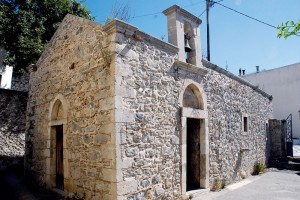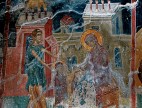All – Holy Virgin the Mesochoritissa [‘of the Middle Land’] at Malles
The single-nave church of the All-Holy Virgin, in the centre of the settlement, was expanded to the west during a second phase. The two construction phases correspond also to the two layers of wall painting decoration that adorn its interior. The older, in the east and central sections, dates to the early 14th century, a period during which the church was founded. Its iconographic programme includes Gospel scenes with the cycle of the Passions on the north side. A large part of the first layer has been hammered in order to achieve the better adhesion of the next layer of wall painting. The peculiarities in technique and iconography, especially of the scenes of the Passions, have connected the painting of the church with an artist also knowledgeable of the Venetian art of the 14th century, in relation also to a small group of similar monuments of the island. The later layer, which develops in the west section of the church and appears not to have covered the east wall, was painted in 1431/32 funded by of the family of George Markatatos. An extensive Marian cycle occupies a large part of it, which begins with the scene of the Offering of Joachim and ends with the Annunciation of the All-Holy Virgin in the Well. The icon of the great painter of the Cretan School, Angelos, of the second half of the 15th century, which depicts Christ as the Vine according to the relevant passage from the Gospel of John (15.1–7), which is kept in the central church of the settlement, may orginate from this church.




